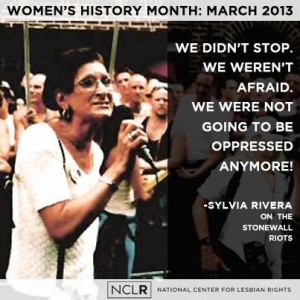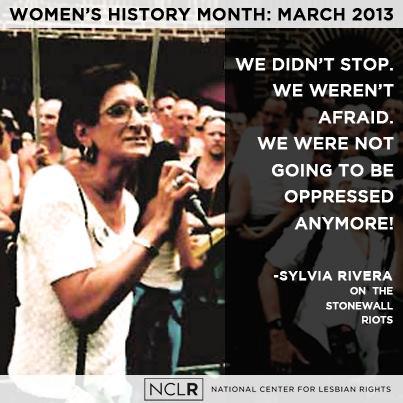LGBTQ-Logue 001.
“The archives of lesbian culture…created four years after Stonewall, owes, at least for my part, it’s creation to that night and the courage that found its voice in the streets. That night, in some very deep way, we finally found our place in history. Not as a dirty joke, not as a doctor’s case study, not as a freak- but as a people.” – Joan Nestle, Co-founder of Lesbian Herstory Archives (Remembering Stonewall, aired 1989 on PBS Radio).

For some, modern history is indexed by the pre-Stonewall and post-Stonewall eras. The 1969 Stonewall Upraising is marked as the first time the LGBTQ community resisted routine police raids and arrests at a time when it was illegal for queers to congregate in public.
All great movements require catalyst- whether it’s premeditated or unplanned- a bandwagon that cements conviction in the will of those affected by injustice; when people discover they are not alone. What starts a movement will be determined by different (sometimes opposing) perspectives, most of which will never be recorded in popular history. Stonewall is one of those seminal events in which thousands who were involved (directly and indirectly) have never had their experiences recognized in official documentation…until 20 years later. StoryCorps founder David Isay with Michael Scherker produced the first documentary of any medium about the Stonewall uprising.
This radio documentary premiered on NPR’s All Things Considered Weekend Edition in 1989. It records multiple testimonies of the event including drag queens who stood up to police, a police marshal who led the raid, and young activists who founded the Gay Liberation Front on the third night of the Stonewall Riots. You can listen and download the broadcast for free at Sound Portaits.org and read the entire transcript here.
The recording begins with participants describing what it was like to be “gay” in the 1960s, before Stonewall.
JOAN NESTLE, Co-founder of Lesbian Herstory Archives: [T]here was regular weekend harassment, which would consist of the police coming in regularly….[I]n the Sea Colony, we had a back room with a red light. And when that red light went on it meant the police would be arriving in around ten minutes. And so we all had to sit down at our tables, and we would be sitting there almost like school children, and the cops would come in. Now depending on…which cop was on, if it was some that really resented the butch women who were with many times very beautiful women, we knew we were in for it because what would happen is they would start harassing one of these women, and saying, ‘Ha, you think you’re a man? Come outside and we’ll show you.’ And the woman would be dragged away. They’d throw her up against a wall and they’d say, ‘So, you think you’re a man, let’s see what you got in your pants.’ And they would put their hand down her pants.
SEYMOUR PINE, Deputy Inspector of the NYC Public Morals Squad: “[Before Stonewall] you tell [patrons in gay bars] to leave and they leave, and you say show me your identification and they all take out their identification and file out and that’s it. And you say, okay, you’re not a man, you’re a woman, or you’re vice versa and you wait over there. I mean, this was a kind of power that you have and you never gave it a second thought.
SYLVIA RIVERA, Transgender activist: The drag queens took a lot of oppression and we had to…we were at a point where I guess nothing would have stopped us…we were ladies in waiting, just waiting for the thing to happen.

Those who witnessed and participated in the riot recount the electricity felt in the air as eight police officers arrived at the Stonewall Inn at midnight June 27th, 1969. They describe fire, anger, joy, beatings- by police batons and high heels alike.
BIRDY, Protestor: My name is Robert Rivera and my nickname is Birdy, and I’ve been cross-dressing all of my life. I remember the night of the riots, the police were escorting queens out of the bar and into the paddy wagon and there was this one particularly outrageously beautiful queen, with stacks and stacks of…Elizabeth Taylor style hair, and she was asking them not to push her. And they continued to push her, and she turned around and she mashed the cop with her high heel. She knocked him down and then she proceeded to frisk him for the keys to the handcuffs that were on her. She got them and she undid herself and passed them to another queen that was behind her.
RIVERA: I remember someone throwing a Molotov cocktail. I don’t know who the person was, but I mean I saw that and I just said to myself in Spanish…’oh my God, the revolution is finally here!’ And I just like started screaming ‘Freedom! We’re free at last!’ You know. It felt really good!
Remembering Stonewall also offers rare insight and expression of how the revolutionary event impacted across personal lives and politics. For example, Gene Hardwood, who at the time of this recording was in a 60 year partnership with Bruce Merrow, explained,
GENE HARWOOD: When Stonewall happened, Bruce and I were still in the closet, where we had been for nearly forty years. But we realized that this was a tremendous thing that had happened at Stonewall and it gave us a feeling that we were not going to be remaining closeted for very much longer. And soon thereafter, we did come out of the closet.
JINNY APPUZO: …In 1969 I was in the convent. And when Stonewall hit the press, it hit me with a bolt of lightening. It was as if I had an incredible release of my own outrage at having to sequester so much of my life. I made my way down, I seem to recall in subsequent nights being down on the, you know, kind of just on the periphery looking. An observer — clearly an observer. Clearly longing to have that courage to come out. And as I recall it was only a matter of weeks before I left the convent and started a new life.
PINE: For those of us in Public Morals [police division], after the Stonewall incident things were completely changed from what they had previously been. They suddenly were not submissive anymore. They now suddenly had gained a new type of courage. And it seemed as if they didn’t care anymore about whether their identities were made known.
We were now dealing with human beings.
As shown by Stonewall and earlier campaigns against police raids and entrapment, NYC has a fraught history of with the LGBTQ communities. While great gains have been made, LGBTQ people, and particularly LGBTQ people of color, continue to be targets of police profiling and abuse. This includes profiling transgender women as sex workers, “gender checks”, physical and sexual abuse, and detention of transgender people under dangerous conditions. Check out LGBTQ-logue 003 for narrative accounts of LGBTQ interactions with the NYPD in present-day Jackson Heights, Queens.
